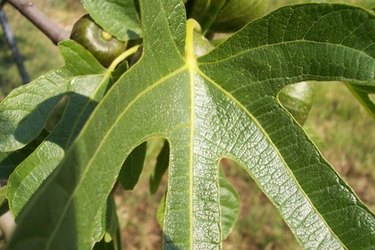
A fig tree in your garden will yield delicious fruit that ripens in the summer and can be dried to eat and enjoy year-round. You may not have thought much about fig leaves, except as an old-fashioned way of covering nudes in paintings. Do not let your enthusiasm for the fruit blind you to the value of the leaves of the fig tree. Many gourmet chefs value fresh fig leaves as flavorful wraps for cheese and fish dishes. The uses of dried fig leaves range from medicinal to perfumery to farming.
Health
Video of the Day
An extract or tea made from fig leaves lowers insulin levels. Individuals with diabetes should take the fig leaf remedy with breakfast to receive full benefits throughout the day. The fig leaf remedy also protects cardiovascular health by lowering triglyceride levels in the bloodstream. Other reported benefits in humans include soothing hemorrhoid pain and lowering blood pressure. Fig leaves also aid in healing shingles, warts and ulcers. Fig tree leaves can be used to treat ringworm in pets.
Video of the Day
Perfume
If you stand near a fig tree on a warm summer day, you will notice the leaves release a pleasant, woodsy-green fragrance. French perfumers crush and distill fig leaves to create "fig leaf absolute." This essence is used in creating perfumes with a woodland scent. Two fragrances that make use of the green scent are Demeter's Fig Leaf and The Thymes' Fig Leaf and Cassis. Some people include dried fig leaves in a potpourri mix to add a light, pleasant fragrance to their homes.
Fodder
In India, fig leaves are used as fodder for livestock. In "Fruits of Warm Climates," Julia F. Morton writes, "They are plucked after the fruit harvest. Analyses show: moisture, 67.6%; protein, 4.3%; fat, 1.7%; crude fiber, 4.7%; ash, 5.3%; N-free extract, 16.4%; pentosans, 3.6%; carotene on a dry weight basis, 0.002%. Also present are bergaptene, stigmasterol, sitosterol, and tyrosine."